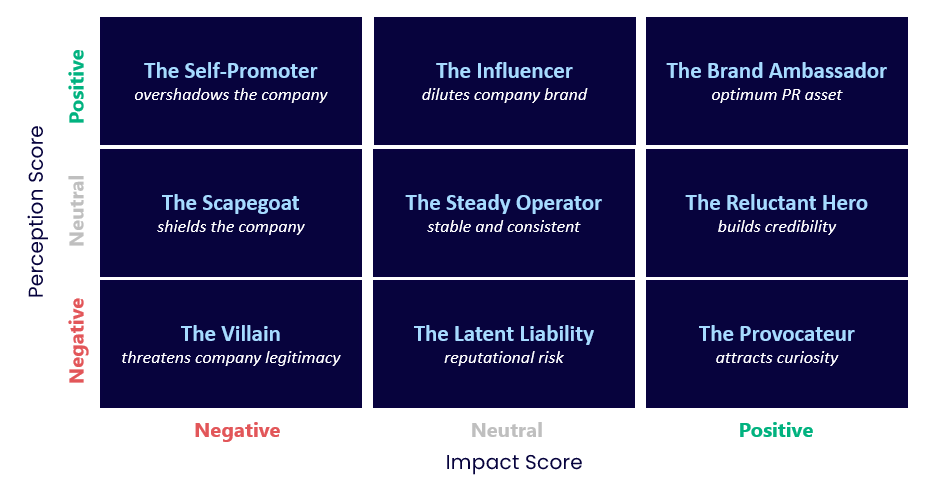
The 9 CEO Archetypes that Shape (or Sink) Company Reputation
A CEO is not just the leader of a company—they’re its public face. Whether they’re boosting brand visibility or creating PR nightmares, CEOs hold significant power over how the world views their companies. Through recent analysis of our CEO Index, we’ve identified 9 distinct CEO archetypes that either enhance or erode a company’s brand reputation. Understanding which archetype your CEO aligns with can provide valuable insight into how to manage their influence on the corporate brand.
Included at the end of this blog is a quiz for communications leaders to identify which archetype their CEO falls into, helping you refine your strategy accordingly.
CEO Perception vs. Impact
First, it’s important to understand Perception versus Impact. PublicRelay tracks CEO performance through our CEO Index, which scores CEOs (from -10 to +10) on two essential factors:
- Perception: How well the CEO is perceived by the media. This includes the sentiment, reach, and sharing of their personal media mentions.
- Impact: How the CEO’s presence influences their company’s media reputation. This measures the sentiment, reach, and sharing of mentions where both the CEO and company are featured.
A CEO can have a negative Perception Score, while having a positive Impact Score, vice versa, or somewhere in between. The 9 archetypes are each defined by the types of Perception and Impact scores they have.

The 9 CEO Archetypes
1. The Self-Promoter
- Features: Known for their strong personal brand, these CEOs often overshadow the company they lead. They blend business, entertainment, and lifestyle media, but the focus remains on them.
- Effects: While their media presence generates short-term buzz, it doesn’t translate to long-term benefits for the company. Employees may feel undervalued, as recognition is tied to the CEO rather than team achievements. Over time, the focus on self-promotion can erode trust in the company’s leadership and values.
2. The Influencer
- Features: Engaging and charismatic, the Influencer CEO is widely recognized as an expert in their field. They are frequently sought out for industry insights, but the media often emphasizes their personal achievements rather than the company’s.
- Effects: While their star power attracts media attention, it often overshadows the company’s brand. This can lead to missed opportunities where the CEO’s media presence could otherwise elevate the entire organization.
3. The Brand Ambassador
- Features: The Brand Ambassador is passionate about the company’s mission and values. They provide transparent insights into company operations and strategy, building trust and credibility.
- Effects: This archetype is highly effective as a PR asset. Their personal reputation enhances the company’s image, attracting customers, investors, and top talent. Employees take pride in their recognition, as it often includes acknowledgment of the team’s contributions.
4. The Scapegoat
- Features: The Scapegoat is often associated with controversy, stepping up to take responsibility when things go wrong. They aim to protect the company and its brand by absorbing the blame.
- Effects: While this CEO’s willingness to accept responsibility can sometimes shield the company from reputational damage, frequent association with controversy raises questions about their overall competence. Over time, this leads to skepticism and damages both the CEO’s and the company’s reputation.
5. The Steady Operator
- Features: The Steady Operator provides consistent, reliable leadership but lacks the flair to capture significant media attention. They focus on delivering factual, straightforward information.
- Effects: Stability and reliability are the hallmarks of this archetype. However, the company may miss opportunities for a dynamic reputation boost due to the CEO’s understated presence. The public sees the company as stable, but without much excitement or innovation.
6. The Reluctant Hero
- Features: Known for making rare, but highly strategic media appearances, the Reluctant Hero focuses attention on the company’s innovations and the team’s contributions.
- Effects: This CEO’s authentic and humble approach builds credibility and trust. The public and media perceive the company as genuine and mission-driven, increasing support. Employees also feel recognized and valued through the CEO’s emphasis on team successes.
7. The Villain
- Features: The Villain CEO is often criticized for poor decision-making and leading the company into controversy.
- Effects: Repairing reputational damage is an uphill battle for this CEO. Their negative perception spills over into the company, making it appear poorly managed and untrustworthy. This typically leads to financial losses and a struggle to regain legitimacy.
8. The Latent Liability
- Features: This CEO may be largely invisible until controversies surrounding their personal behavior or past scandals surface. They appear disconnected from the company’s core mission and values.
- Effects: Although the company may not immediately suffer from this CEO’s negative reputation, their continued presence can gradually erode trust, leading to long-term damage. Communications teams find it challenging to use this archetype as a PR asset, as their media presence poses more risks than benefits.
9. The Provocateur
- Features: The Provocateur is known for bold decisions and outspoken views that generate controversy. However, their vision often drives innovation and change.
- Effects: Despite the initial skepticism, this CEO’s resilience in the face of controversy can eventually shift public perception in their favor. Their ability to generate buzz and attention often puts the company in the spotlight, helping the brand stand out as innovative and forward-thinking over time.
Real-World Examples
Jamie Dimon (JPMorgan): Starting as a Scapegoat in media coverage of JPMorgan’s controversial return-to-office policy and a tough business environment, Dimon transitioned into an Influencer archetype as he distanced himself from scandals and focused on thought leadership. This pivot meant he stayed out of highly shared negative coverage around compliance controversies and more, but his personal brand may now eclipse the bank’s. If he were to leave the organization, his influence would leave with him.
Ryan Lance (ConocoPhillips): Lance is a Reluctant Hero, having managed to avoid being drawn into coverage on environmental and climate change issues companies, all the while strategically appearing in the spotlight to highlight business wins, positioning the company positively without taking much in the way of personal credit.
How CEO Archetypes Shape Brand Strategy
Each of these archetypes presents unique challenges and opportunities for communications leaders. The key to maximizing brand impact is understanding which archetype your CEO aligns with and adjusting your communications strategy accordingly.
Self-Promoters may require media strategies that balance their personal brand with the company’s message.
Brand Ambassadors can be powerful spokespersons for company values, but Villains and Latent Liabilities may require crisis management plans to mitigate their negative perception.
By identifying your CEO’s archetype, you can tailor media strategies to enhance their strengths while mitigating risks.
Understanding CEO archetypes is essential for communications professionals tasked with managing brand reputation. With the right approach, and the right media measurement support, you can leverage your CEO’s strengths to align their personal brand with the company’s goals and protect your organization from reputational risks.
Take the Quiz: Which Type of CEO Are You Working With?
Curious about where your CEO falls in the archetype spectrum? Take this brief quiz to discover their CEO style so you can tailor your communications strategy for maximum brand impact.
1. How does your CEO typically engage with the media?
A) They are the face of the company and often appear in interviews, even in non-business contexts.
B) They are sought after for their expertise and frequently share insights on industry trends.
C) They tend to be in the spotlight mainly during crises or controversies.
D) They provide calm, factual statements and avoid the limelight whenever possible.
2. How do your CEO’s media engagements affect the company’s brand?
A) The CEO’s strong personal brand often overshadows the company’s brand.
B) The company’s brand can sometimes feel secondary compared to the CEO’s personal recognition.
C) The CEO regularly shields the company brand by taking accountability during controversies.
D) The CEO generates little excitement or buzz, but the company is seen as reliable.
3. How do employees perceive your CEO’s media presence?
A) Employees often feel overlooked, as the CEO rarely mentions the efforts of the team in public.
B) They are proud that the CEO is well-respected in the media, but there’s a sense that the CEO avoids getting involved when the company faces controversies.
C) Employees appreciate that the CEO takes public accountability when things go wrong.
D) Employees see the CEO as competent and reliable, though not particularly inspiring.
4. How does your CEO handle controversies or negative publicity?
A) They tend to deflect media focus away from company scandals by drawing attention to themselves instead.
B) They continue to provide industry commentary and thought leadership in the media, but avoid publicly addressing controversies.
C) They step forward, take responsibility, and try to shield the company from further damage.
D) They address the issues calmly and factually, avoiding any dramatic statements or actions.
Results:
If you answered mostly A’s: Your CEO is The Self-Promoter.
Your CEO has a strong personal brand that often overshadows the company. They bridge the gap between business, entertainment, and lifestyle media, but this doesn’t always translate into benefits for the company.
If you answered mostly B’s: Your CEO is The Influencer.
Your CEO is charismatic and widely recognized for their expertise. While they attract a lot of attention, their strong personal brand can sometimes make the company’s brand seem secondary.
If you answered mostly C’s: Your CEO is The Scapegoat.
Your CEO often takes the blame during controversies, acting as a shield for the company. While this can mitigate reputational damage, it can also lead to skepticism about the CEO’s overall competence.
If you answered mostly D’s: Your CEO is The Steady Operator.
Your CEO delivers consistent and reliable leadership without seeking the spotlight. The company is perceived as stable, but there may be missed opportunities to enhance the company’s reputation.